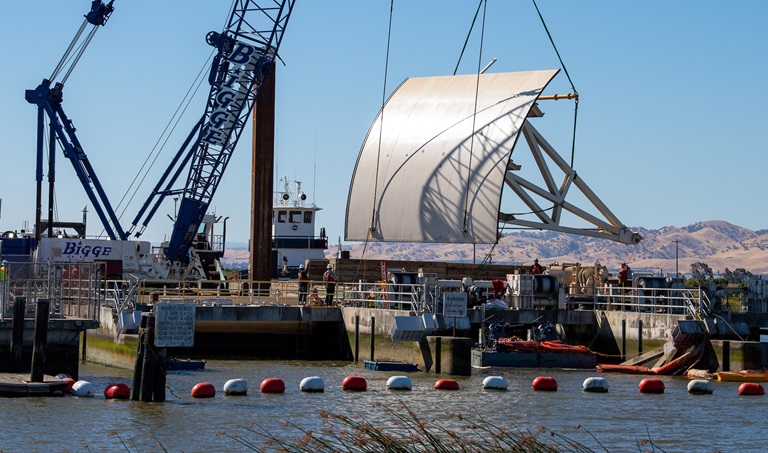Refurbishment Work Underway for Suisun Marsh Salinity Control Gates
One of the refurbished gates is reinstalled with the help of a large crane at the Suisun Marsh Salinity Control Gates.
The Department of Water Resources (DWR) refurbished the first of three 95,000-pound radial gates that help reduce saltwater intrusion into the Suisun Marsh in Solano County. The work took place at the Suisun Marsh Salinity Control Gate Facility, which has operated since the late 1980s. The project is part of a multi-year effort to remove, refurbish, and reinstall the massive gates at this facility.
“Over time, the gates themselves, as well as the structure itself decay,” explained mechanical engineer Brandon Becker with DWR’s Operations and Maintenance (O&M) Division. Becker added while corrosion protection had been previously applied to the gate, “that only lasts for so long before that protection starts to wear away with time and continual use. It comes time when you need to take the gate out and repair it.”
One of the reasons for that wear and tear is that the gates operate in the Suisun Marsh, located south of the city of Fairfield, which is the largest remaining brackish water wetland on the West Coast. This is where salt water from the San Francisco Bay meets fresh water from the Sacramento-San Joaquin Delta.
According to DWR Senior Environmental Scientist Phil Choy, the Marsh is special. “It provides a unique habitat that is essential for sensitive, endemic species that aren’t found elsewhere in California and along the West Coast,” he said.
As California experiences a third year of dry conditions, this is one of the most extreme years for the State to not receive much fresh water. Choy notes the biggest impact to species such as the California Clapper Rail, American White Pelican, Great Egret, and Salt Marsh Harvest Mouse at the Marsh is salinity.
“The Salinity Control Gates are one of the mechanisms DWR uses to ensure the water quality in the Suisun Marsh is fresh enough to promote waterfowl habitat for managed wetlands,” Choy said.
The facility’s three gates raise and lower depending on tidal flow in the Marsh. DWR Suisun Marsh Program Coordinator, Rhiannon Klingonsmith, explained the gates close when the tide comes in, providing a blockage to the saltwater. The gates raise when the tide goes out, which allows fresh water to flow in.
“The gates help provide the fresher water that’s needed for the native species to survive,” Klingonsmith said.
To make sure everything continues to function properly, the gates required refurbishing of parts and paint. But Becker points out that is easier said than done.
“The hardest part is access – getting the gate to and from the facility,” Becker said. “We have a large barge and large crane. The gate is not something you can load up onto a truck and take down the freeway.”
The refurbishment project kicked off two years ago with the removal of Gate 3. Modifications and refurbishment of the gate took about 10 months and included:
- New coating -- old coating is removed and welds are inspected
- Repairs to damaged portions of the gate due to corrosion and wear over time
- Replacement of all seals and rubber material
- Fabrication of new gate arm pins
- Modification of the gate yokes (hinges)
Before that work could happen, DWR’s Operations and Maintenance (O&M) Division built a heavy stoplog to be placed in the bay of Gate 3 to prevent water from freely flowing. Gate 3 was reinstalled on Aug. 22, which involved transportation by barge, being lifted by a heavy crane, and carefully aligned. Two days later, Gate 1 was removed and placed on the giant barge to be transported to the refurbishment facility. The stoplog will stay in the bay of Gate 1 while it undergoes refurbishment.
“With the next two gates, we’re going to do one per year,” Becker said. “Pretty much the whole downtime leading up to the next install will be the repair work associated with getting the next gate ready.”
The Suisun Marsh Salinity Control Gates Facility has operated since 1989 as part of the State Water Project. The facility is one of several in the area, including 17 water quality monitoring stations, and it is one of the methods DWR has used to help reduce saltwater intrusion into Suisun Marsh.
For photos of the gate installation and removal visit DWR’s Pixel gallery.
For video of the gate installation and removal visit our YouTube channel.
